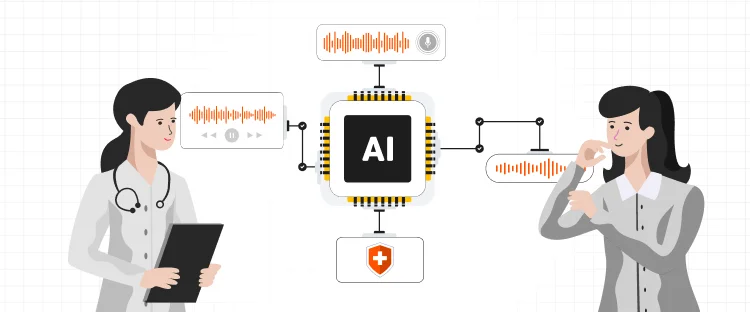A medical document is a document that’s legal in nature and contains information about patient healthcare, medical research, or drug trials. Doctors and medical experts with expertise in medical diagnosis, treatment, and public health research generally prepare these documents.
Based on how the information is generated and processed in healthcare, we can actually differentiate the documentation into clinical and non-clinical.
Clinical documentation is the information linked to the patient’s medical condition or treatment. This could be the patient’s family history, medical history, and any other details that a healthcare provider caring for the patient should know. Because of this, accurate clinical records are necessary for better patient care and compliance.
Contrary to this, non-clinical documentation refers to the administrative records that are required for the provision of care. It is therefore understood to include any social or administrative documents that support effective management and coordination, as well as the organization of the existing means and resources. These documents also allow for the proper operation of the various departments that comprise the care process, such as primary care and specialized care departments.
Medical documentation is no doubt a crucial component of patient care. We as a translation company have worked with numerous healthcare clients over the last two decades and assisted with the translation of various medical documents. Based on our experience, we’ve compiled a list of the most popular documents for you below.
Keep reading if you want to know which documents, you as a healthcare provider, should get translated.

One of the most important forms to use in your medical practice is this patient information form. It gathers all the fundamental data about the patient’s health, which you can subsequently enter into the EHR (electronic health record).
Before the appointment begins, your front desk personnel will provide this form to patients asking them to complete it. If your patient speaks a language other than English, let’s say Spanish. They’ll have an easier time if you give them a form that’s also in Spanish. As they will now find it simple to fill out the form in their native language.
What to include in the patient information form? Well, it can have elements such as contact info, medical history, and what changes a patient has witnessed since their last trip to the doctor. Although you can make it as detailed as you like, we recommend keeping it to no more than two pages.

This document should also be kept fairly short and concise. It outlines your patients’ rights as well as their responsibilities when they visit your practice.
Please be mindful that one of those patients’ rights is to have an interpreter available to them. That too, at no cost to them.
You can simply print a sign and place it near your reception area. It should tell the visitors that you have interpreter services available for their benefit.

This is one area where you may not essentially require translation. As far as the history questionnaires are concerned, you can write all the answers down a patient provides by seeking help from an interpreter. When you conduct the patient’s interview, the interpreter’s role will be to communicate information between you and the patient. They will be communicating with you in English but with patients in their own first language. So, they relay the patient information back to you, your job would be to note it down in English for your own help.
However, with progress notes, this can get quite tricky. Say, a patient comes to you and presents their progress notes in Chinese or Spanish. These notes could be in a different language, but they contain vital information. Hence, you will have to get them translated from Chinese or Spanish into English.
If the progress notes are written in the form of handwritten text, they must be difficult to read. Add to that the fact that a nurse or doctor had done this handwriting and that too in a foreign language such as Spanish. Things can get more difficult.
What can you do here? You can scan them into PDF format and send them to your translation partner who will get them translated. But remember, this is the only time when you should scan your documents.

It’s obvious that your patients will be in need of certain instructions after they pay you a visit. By following these instructions, they can get to a better condition. And the patients may need them before they visit you again.
There are various procedures that require preparation such as colonoscopy. And a patient does that by following instructions from the doctor.
For instance, you might have treated a patient with a sports-related injury. For effective treatment, it’s critical for them to know what instructions they should follow. By having such instructions at their disposal, you can let them know what to do and what not to do.
As a result, it’s imperative that you translate such instructions and provide them to the patients.

Last-minute cancelations, no-shows – well, no one likes them at all. They are a complete time waste for everyone, even for the staff you have at your practice.
Now consider the fact that time equals money. What happens when a patient fails to appear for the appointment? Simple, you lose money. Is the interpreter also expecting you to compensate them in such cases? Of course, they are.
So, in order to get through such circumstances, most care providers will have a missed appointment policy in place. It will not only encourage patients to not miss appointments, but the care providers can charge them for any missed appointment. Yes, this is ethical as per the American Medical Association.
But, what if patients don’t know about your policy? You will have to inform them in advance. This calls for the translation of your missed appointment policy. When you have it translated into different languages, you can provide your policy to various patients in their own language. Now your patients understand what the consequences are if they miss the appointment.
It’s not sufficient that you provide your patients with interpreting services. You should also provide them with content that’s translated into their native languages.
Now that you have a list of recommended documents for translation, it should be a solid starting point for your practice. You will achieve a greater level of patient satisfaction by doing so. This will also reduce the likelihood that Title VI or other regulations may be violated.
How can MT help? We have hundreds of seasoned, in-country translators operating in every language and domain. No matter what medical documents you need to be translated, we’ll always deliver you professional standard translations, always.
It’s true that translating these documents will cost you money, but the benefits will last a lifetime.

Colorado is said to be one of the best places to do business because the business environment is very friendly
Read More
The global marketplace has become an attractive place for brands and businesses, where they strive to create a presence of
Read More
CAD, or computer-aided design and drafting (CADD), is the use of computer technology for design and design documentation. CAD software
Read More
Many global companies, foreign governments and Iranian are hoping to see an increase in investment in Iran after declaring the
Read More
Artificial intelligence has taken a big space in almost every industry. There is also a widespread acceptance that AI is
Read More
Persuasion is all about manipulating other people behavior. At first it might sound immoral but it doesn’t have to be.
Read More
Now days everyone is searching for good ideas for their company they wanted to be more creative, they wanted to
Read More
Technology has now much diverse roots in this age of development. Now it is not wrong to say, that you
Read More
Localization is the practice of altering the functional properties of a product and also its characteristics. This is easily done
Read More


Document Translation
Professional document translation by native expertsApp Localization
Get more downloads by adapting your app for different target marketsVideo Translation
Multilingual translation and subtitling servicesWebsite Localization
Adapt your website into multiple contexts for global reachSoftware Localization
Adapt your software for global usersGame Localization
Reach new players with localized gameplayMTPE
Refine AI translations for natural fluencyBusiness Translation
Professional translation for business documents and websitesDTP & File Conversion
Professional DTP and File conversion, supporting multiple file formatsProofreading
Perfect your content with expert review© Copyright 2025 MarsTranslation